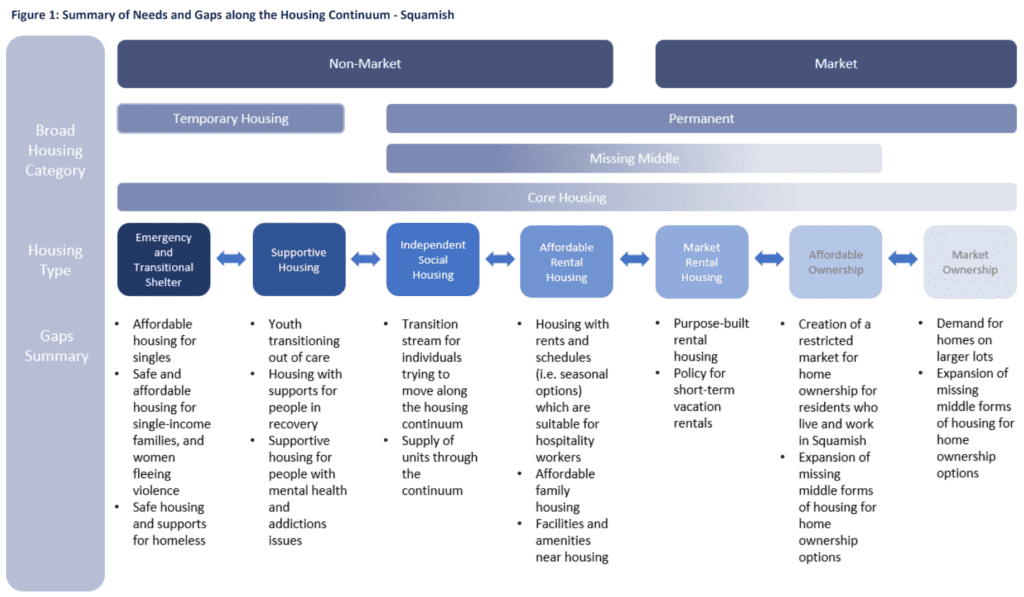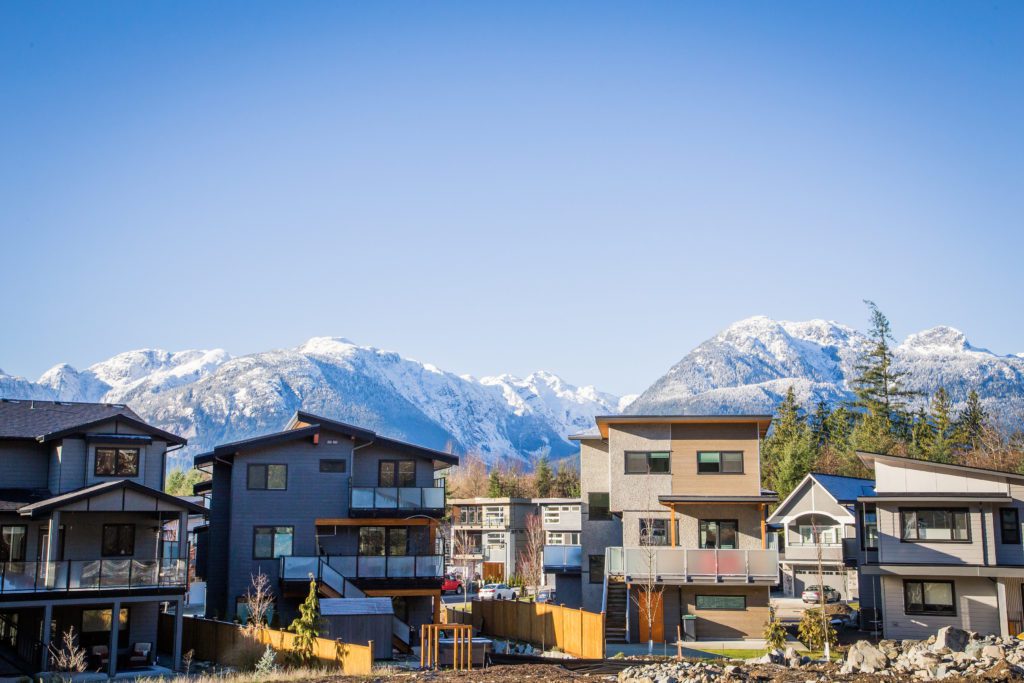- CHAMBERS PLAN
- LOVELOCAL
- WHY SQUAMISH
arrow_drop_down
- MEMBERSHIP
arrow_drop_down
- DIRECTORY
arrow_drop_down
- EVENTS & TRAINING
arrow_drop_down
- RESOURCES
arrow_drop_down
- ADVOCACY
arrow_drop_down
- ABOUT US
arrow_drop_down
- CONTACT
Understanding Affordable Housing In Squamish – Guest Blog
Read our latest guest blog from Squamish Chamber Director Cameron Cope, Owner & Operator, Our Squamish.
As Squamish continues to grow, it is essential to get a better understanding of the factors contributing to the housing affordability problem. #squamishchamber #housingaffordability
Housing affordability, though currently eclipsed by today’s pandemic, is on everyone’s mind. It’s a loosely-defined concept that everyone seems to understand a little differently. Most often, (and according to Canada Mortgage and Housing Corporation) housing is deemed affordable when the household is paying less than 30% of their before tax income on housing, whether that be rental or ownership. Squamish is going on five years with a vacancy rate of less than 1% (nationally it sits around a still-low 2.4%), and more than one-third of renters are paying above the ‘affordable’ 30% of their income mark. (District of Squamish website)
Diversity is a strength of our community, and there is no silver bullet solution to address everyone’s needs. As Squamish continues to grow, it is essential to get a better understanding of the factors contributing to the housing affordability problem. Together we will explore what brought us here, then discuss the housing continuum and how a holistic approach can support us in achieving a vibrant, healthy, and prosperous community.
"There is no one-size-fits-all answer to solving the housing affordability problem. The answers lay in multiple approaches that provide more affordable housing across the housing continuum. "
HOW DID WE GET HERE?
Perhaps surprisingly to some, this is not the first-time affordability challenges have visited this town. Natural resource booms in the 60’s brought in a flood of workers, and, quick to follow, housing shortages. In the years to follow Squamish’s housing market was relatively stable, that was until the construction boom leading up to the 2010 Olympics where prices rose significantly. Since 2011, Squamish’s population rose by 4,500 and Squamish’s Official Community Plan projects the population to reach 30,000 by 2031 and 34,000 by 2036.
Squamish’s growth in popularity has contributed to the current shortage. With the upgraded highway, Squamish became within easy commuting distance to Vancouver. Publicity such as the New York Times recommending Squamish as one of the top places to visit in 2015 has also drawn newcomers from across the country and the world. Demand is outstripping supply, and prices outstripping wallets.
The biggest challenges are often faced by lower income families and individuals, but those in higher income brackets can’t claim immunity to affordability challenges either. Home ownership has become a difficult to impossible dream for many. There are spill over effects into other realms of the community; business owners repeatedly report how difficult it is to find and retain staff because there is nowhere for staff to live. The Chamber of Commerce and Tourism Squamish corroborated this in a poll which found 76% of businesses have found challenges recruiting or retaining staff in the previous twelve months leading up to the survey. (Labour + Housing: The Impact on Squamish Businesses, 2018).
However, people are finding ways to make it work; Sea to Sky Gondola leased dorm rooms from Quest University last summer for their employees. Homeowners may rent rooms or suites to help pay their mortgage. Keen to keep existing rental, the District of Squamish is enacting a zoning bylaw that locks certain properties with rental buildings into remaining rental if redeveloped. Some question this approach, as it may de-incentivise new rental construction.
There is more to housing affordability than a monthly payment. Taking a holistic approach, one also has to consider transportation costs, household bills, and daycare expenses, to name a few examples. Is your housing really affordable if its location means you’re spending an extra $500 a month on gas for commuting? What about the electricity costs that skyrocket in winter when trying to heat a poorly insulated home? And finding daycare can add additional costs and complexities if it is not easily available.
HOUSING CONTINUUM
There is no one-size-fits-all answer to solving the housing affordability problem. The answers lay in multiple approaches that provide more affordable housing across the housing continuum. The housing continuum is best described as a range of housing options to fit each household, from emergency shelters to home ownership. Housing affordability issues affect mid-income and low-income households differently, as well as affect renters and owners differently. Individual and family needs can vary by size, location, number of rooms, density, and budget. True housing solutions need to address the spectrum of housing needs, as impacts on affordable supply in one part of the spectrum (ex. mid-market) can have impacts elsewhere on the spectrum (ex. availability of temporary rental).
Let’s take a look at housing across the continuum.

To provide for our society’s’ most vulnerable, the Housing First Policy is a good place to start.
The idea behind the Housing First Policy is that before someone can recover from the struggles they may face; they need a safe place to call home. A deeply subsidized rental unit, such as those to be found at Squamish’s Under One Roof project, gives people a home and supportive resources.
Moving along the housing continuum, non-market housing typically cannot be bought or sold for a profit, which keeps it affordable in perpetuity. Housing co-ops, land trusts, and non-profit housing corporations fit this category. Non-market housing rental rates can be geared-to-income, set at 30% of household income, and require continuous subsidized funding for ongoing operations. Further along the continuum are unsubsidized non-market rentals with rents often set at 80% or 90% below market rates. With higher, but still below-market rents, these buildings don’t require ongoing outside funding, as rents support operations and maintenance. There are often guidelines on maximum incomes and asset holdings, ensuring non-market housing is available to those who need it most.
Next along the continuum, we come to market rental where prices match what people are willing to pay – be it begrudgingly. According to basic supply and demand principles, a larger supply of market rental units translates into lower rents. There are some new purpose-built rental apartments on the horizon for Squamish, but not yet enough to meet our growing community’s demand. According to the 2040 Official Community Plan, “Squamish could see approximately 24,000 new residents by 2036 with an associated housing need for 9,600 new units, or 480 units per year.”
Homeownership rests in many people’s eyes as the ultimate place to be on the housing continuum. The conventional dream is still to own a single-family dwelling, a choice that doesn’t necessarily improve quality of life. Town homes and condos can complement the holistic approach to affordability, selling at a lower price, and combining cost savings on home maintenance with amenities, walkability, and community.
Another driver of housing affordability is the rules surrounding mortgages. Since 2009, there have been over 60 changes to mortgage rules and policies by OSFI, CMHC, or Finance Canada. The changes were made to lower consumer debt (student debt, credit card loans, car payments, etc) and had the effect of restricting who could qualify for a mortgage. This not only made housing less attainable to potential buyers, but put more pressure on the rental market that those buyers were forced to stay in.

SOLUTIONS
Now that you have a feel for the housing continuum and the reasons behind Squamish’s housing affordability crunch, let’s take a look at what can be done about it locally.
Though housing affordability falls within provincial jurisdiction, municipal government is often at the forefront of dealing with everyday affordability challenges and fielding public criticism. What power does local government have when it comes to affordable housing?
Projects & Initiatives
The District of Squamish is taking direct actions to provide affordable housing. A Housing Task Force, convened in 2015 by the District, produced a report and recommendations for moving forward. From here the District engaged a consultant to develop a long‐term municipal affordable housing program report. The report “recommended that the District prioritize the development of low‐to‐moderate income rental housing units that secure and perpetuate permanent, non‐market rental housing units in the District.” (District of Squamish, Affordable Housing Program Final Report)
Such rental housing units are coming, thanks to a partnership between the District of Squamish, BC Housing, and Sea to Sky Community Services. The development, commonly referred to as the Buckley project, will add seventy-six new affordable rental apartments upon completion. It’s a good start, but not nearly enough. As found in the Affordable Housing Program Final Report, we need new non-market rental buildings quickly to relieve pressures on the housing market so people can find a home that they can afford. The Housing Needs Assessment identified a critical need for 488 new affordable rental units though given the current rental situation, stated that the need is likely even greater.
Zoning and Policy
Through zoning and policy, local governments can regulate density, home types, mix of use, and amenities: alternative modes of transportation (transit, walking, and cycling) can be prioritized, lessening the need to use a car or truck; daycares can be included in new buildings, providing convenient and affordable childcare; environmental standards result in more energy efficient homes (a tough sell to consumers who often don’t want to pay for the up-front costs) leading to long-term savings on utilities; density, especially when a human-centric approach is taken, allows for affordable homes while building the critical mass of people needed to bring life to the streets, facilitates alternative modes of transportation and allows new businesses to flourish. The District of Squamish has been actively pursuing this approach.
Prioritization
It can take years of process and patience to get a piece of land to the construction phase. More rental units were needed five years ago – recall five consecutive years below 1% vacancy – our community can’t afford to wait for rental building approvals. Realizing this, the District has developed a priority program which puts 100% purpose-built rental buildings at the front of the queue, along with energy efficient buildings, to fast-track approvals. Currently there are five spots in the priority program. We may need to see more spots created in the future so as not to hinder more rental projects coming through.
SUMMARY
Squamish is such an amazing place to live. To keep it thriving and diverse, it needs to be affordable. In summary, what we need to see going ahead is:
More housing: On the most basic level, there is a discrepancy between the supply and demand for housing in Squamish.
Variety: Build to suit the needs of our diverse community.
Purpose built rental: Less than 1% vacancy rate is not ok.
Sensitive Density: More residents support more vibrant, connected, and prosperous communities
Holistic Approach: Consider the costs associated with housing type and location beyond the monthly payment.
Policy: The Chamber of Commerce continues to gather, analyze, and share data to demonstrate housing challenges and incite solutions.

Cameron Cope
Cameron opened his first business in Squamish, a food truck, eight years ago as a Quest University Student. At the time, municipal restrictions on business prevented him from getting a business license and limited his operations to selling one day a week at the Farmers Market; the business had to close. He has continued on to open a construction business, and is now a Licensed Builder and owner of Regen Homes, an ecological development company. In 2019 he founded OurSquamish, a non-profit with the mission to improve Squamish’s public spaces, build community, and increase livability.
Views and opinions expressed in guest blogs are those of the author(s) and do not necessarily reflect the official position or advice of the Squamish Chamber of Commerce.

